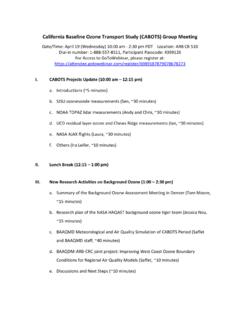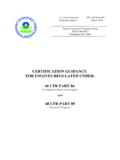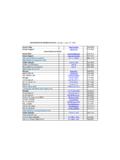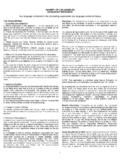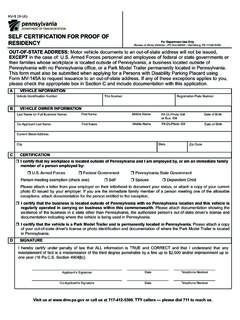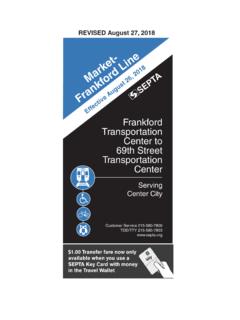Transcription of REDUCING FORMALDEHYDE EMISSIONS FROM Composite …
1 PO BOX 2815 SACRAMENTO CA 95812 (800) 242-4450 COMPWD California Environmental Protection Agency | AIR RESOURCES BOARD FREQUENTLY ASKED QUESTIONS FOR CONSUMERS REDUCING FORMALDEHYDE EMISSIONS FROM Composite Wood Products What are Composite wood products? Composite wood products are panels made from pieces, chips, particles, or fibers of wood bonded together with a resin. The California Composite Wood Products Regulation (CWP Regulation) specifically focuses on three products: hardwood plywood (HWPW), particleboard (PB), and medium density fiberboard (MDF). The regulation also applies to Composite wood products used in finished goods such as cabinets, doors, furniture, flooring products, moldings, toys, mirror and photo frames, audio speakers, base boards, shelving, and countertops. The regulation requires finished goods to be made with HWPW, PB, and MDF that comply with the regulatory requirements and to be labeled as such. If you purchase panels or finished goods, you will likely encounter a label on the product(s) that includes phrases such as California 93120 Compliant for FORMALDEHYDE or California Phase 2 Compliant.
2 Seeing FORMALDEHYDE , an identified toxic air contaminant, on labels may raise concerns about whether a given product is safe to use or not. Below, we provide answers to commonly asked questions about Composite wood products. What does California 93120 Compliant for FORMALDEHYDE or California Phase 2 Compliant mean and why is this label showing up on more products? The label seen on panels and finished goods indicates that the product meets the California Air Resources Board s (CARB) stringent emission standards for FORMALDEHYDE EMISSIONS from Composite wood products, including HW PW , PB, and MDF. The CWP Regulation took effect in 2009, and manufacturers and fabricators of finished goods that use any of these materials are required to use Composite wood that meets the FORMALDEHYDE emission limits in the CWP Regulation. They are also required to label their products as complying, either on the products or the packaging for the finished goods.
3 Manufacturers typically will label their products as California 93120 Compliant for FORMALDEHYDE or California Phase 2 Compliant, although other variations may also be used. California s CWP Regulation is one of the most stringent regulations in effect to limit FORMALDEHYDE EMISSIONS from Composite wood products. As of today, the CWP Regulation is only being implemented in California; other states have not adopted similar regulations. However, the Environmental Protection Agency is developing a national regulation based on California s regulation, which is expected to be in effect nationwide by 2014. What is FORMALDEHYDE and what are the health effects of FORMALDEHYDE exposure? FORMALDEHYDE is a colorless gas and is released to the environment from a variety of sources including the combustion of fossil fuels such as gasoline and propane, tobacco smoke, fireplaces, and wood burning stoves. It is also found at low levels in natural wood.
4 It is commonly used to make a variety of products including resins that are used as adhesives in Composite wood products. It is also found in many other products, including some furniture coatings, permanent press clothing and linens, wallpaper, carpet products, and personal care products such as nail hardeners. Health effects can include nose and throat irritation, a burning sensation of the eyes, wheezing, difficulty in breathing, and can trigger asthma symptoms in those with asthma. Sensitive individuals may experience fatigue, headache, and nausea. FORMALDEHYDE is also a known human carcinogen. Are labeled products safe for my family or should I return/discard the product? From a public health standpoint, the CWP Regulation s emission standards are set at low levels intended to protect public health. The first emission standards (Phase 1) went into effect in 2009. The more stringent Phase 2 standards are now in effect for all Composite wood panels and finished goods sold in California.
5 Prior to the CWP Regulation, FORMALDEHYDE EMISSIONS were often ten to twenty-fold higher than the current allowable levels. PO BOX 2815 SACRAMENTO CA 95812 (800) 242-4450 COMPWD The finished product I purchased emits a strong, unpleasant odor. Is that odor from the FORMALDEHYDE ? While many Composite wood materials used in finished goods are made with urea FORMALDEHYDE -based resins, other chemicals in varnishes, decorative finishes, paint, etc., used in the assembly of such products may also contribute to the odor. So just because a product smells, it doesn t mean that it is off-gassing FORMALDEHYDE . For products that are made with FORMALDEHYDE based resins or adhesives, rapid off-gassing of FORMALDEHYDE occurs initially when the product is made, and over time the FORMALDEHYDE EMISSIONS decrease. What can I do to alleviate the obnoxious smell and EMISSIONS in my home? Proper ventilation, such as opening up windows, bringing fresh air through a central ventilation system, and running exhaust fans, will expedite FORMALDEHYDE off-gassing from finished goods in your home as well as the odors from any finishes such as varnish or lacquer.
6 You may also leave your new product(s) in the garage for a few days to let it off-gas before bringing it inside. An increase in temperature and humidity can increase FORMALDEHYDE EMISSIONS . Keeping the temperature and humidity low, such as by using an air conditioner in hot summer months and using a dehumidifier to draw the moisture out of the air when humid, may help decrease the amount of FORMALDEHYDE that off-gasses into the indoor air. Are there finished products with no FORMALDEHYDE EMISSIONS ? The CWP Regulation includes provisions for no-added FORMALDEHYDE (NAF) and ultra-low emitting FORMALDEHYDE -based resins (ULEF), to encourage the use of these lower-emitting resins in Composite wood products. However, it is difficult to know if a product is made with these materials unless a manufacturer or fabricator promotes their product as such or specifies it on their product or label. Under the CWP Regulation, a manufacturer or fabricator of NAF/ULEF products may elect to simply label their product as Phase 2 compliant, even though their product emits less FORMALDEHYDE than the Phase 2 levels.
7 The product I purchased in California is not labeled. Is it safe to assume that it is compliant for the CWP Regulation? All finished products (panels and finished goods) sold or supplied to California are required to be compliant. Due to a transitional period, which allows businesses to sell noncompliant inventories for a specified amount of time, there may be some products still on the market that only meet Phase 1 emission standards. Retailers (such as big box stores, small retailers) are allowed to sell Phase 1 compliant products until December 31, 2013. While many retailers sell/supply Phase 2 compliant products, legally they can also sell Phase 1 compliant products from their existing inventory through December 31, 2013. Also, if you do not see a label on the product, it does not necessarily mean that it is not a compliant product. The CWP Regulation requires that fabricators either label the finished goods or the boxes the products are shipped in.
8 If you are unsure whether the product you purchased is compliant, you may ask your retailer for verification. Where can I get more information? For more information please visit CARB s Composite Wood Products website at: You may also call or email any of the following staff: Lynn Baker, (916) 324-6997, or Maria Vacaru, (916) 322-7433. If you need this document in an alternate format ( Braille, large print) or another language, please contact Maria Vacaru, (916) 322-7433. TTY/TDD/Speech to Speech users may dial 711 for the California Relay Service.
